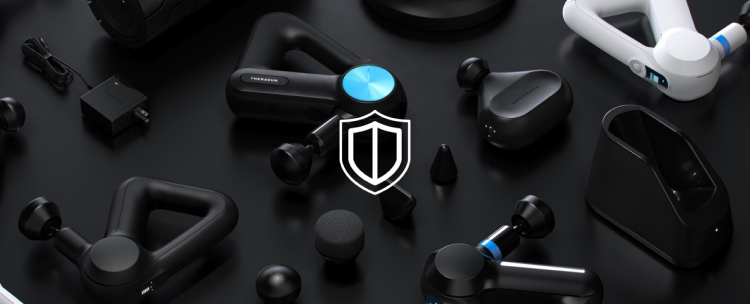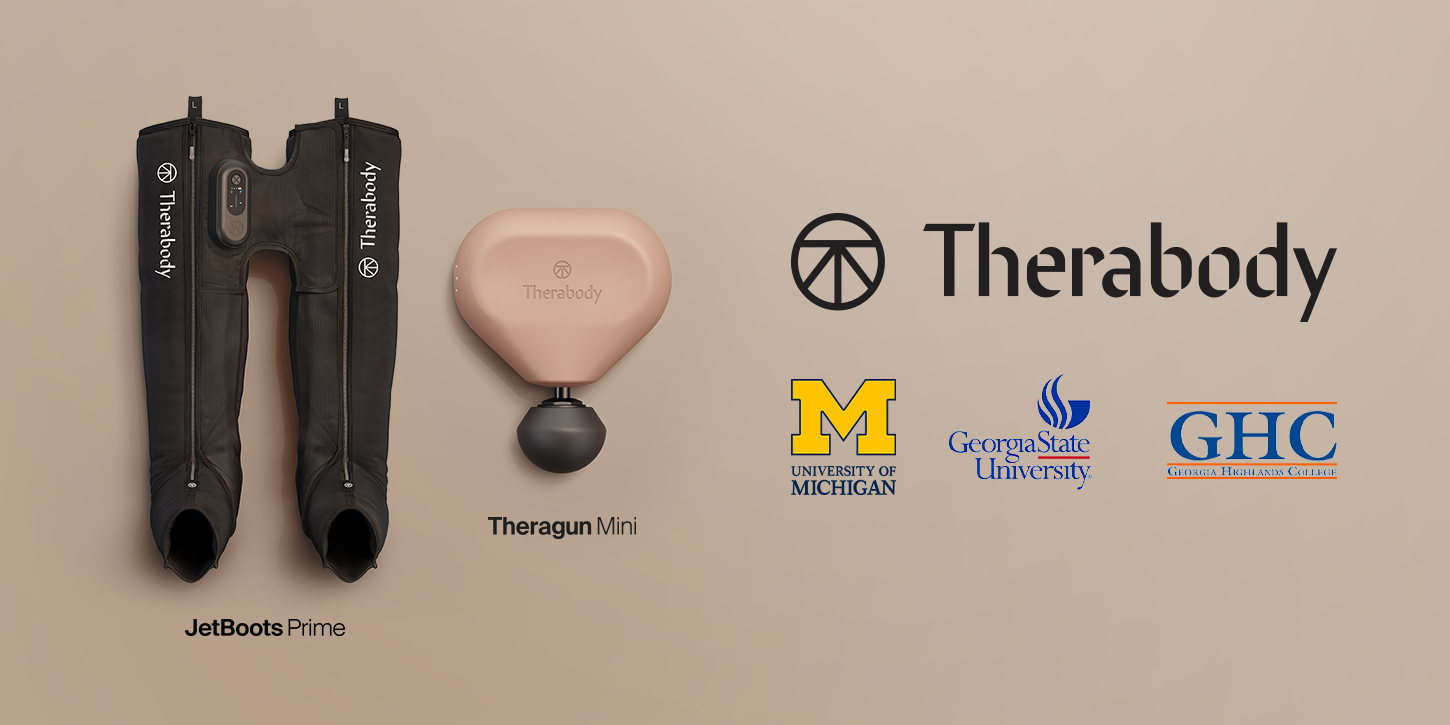Authors: Therabody Scientists: Tim Roberts, MSc; Rachelle Reed, PhD, MS, ACSM-EP; Kyle Silvey, PhD, CSCS; Michelle Darian, MS, MPH, RD, LDN
Therabody’s commitment to leading with science has enabled exponential growth of its medical device portfolio. The modalities included in these devices provide therapeutic benefits to many populations and serve diverse needs globally.
Scientific research is at the core of how Therabody® creates innovative wellness technology. Today, Therabody Labs partners with industry-leading experts to conduct high-quality scientific research and support technology development and product education. Therabody’s scientific and evidence-based approach to technological innovations differentiates its technology from the rest of the pack.
As the industry’s scientific leader, we recognize the importance of prioritizing internal research initiatives in addition to learning from and partnering with world-renowned scientists and experts in key wellness, performance, and health research.
That’s why Therabody launched its inaugural research grant program. In 2024, research investigators across the US submitted grant proposals to study novel topics in audiences commonly underrepresented in scientific research. From using Therabody’s devices to support wellness, performance, overall health, and more, the projects submitted can change our understanding of human health.
Now, we are incredibly excited to announce two research projects awarded Therabody’s 2024 Research Grants.
Physical Activity and Percussive Massage Therapy for Reducing Pain in Older Women
Many barriers exist to being physically active on a regular basis. Getting consistent exercise becomes even more challenging with age as aches and pains become more burdensome. The irony is that remaining physically active is one of the most important health habits for everyone to engage in for overall health and longevity. It’s also widely recommended for pain management and maintaining physical function in older adults. However, pain is also a commonly cited barrier to physical activity. [1, 2]
It’s especially important for older women to be physically active. Postmenopausal women are at an increased risk of developing osteoporosis (a decline in bone mineral density) than their male and younger female counterparts. This is because menopause is associated with hormonal changes that negatively impact bone and muscle (more on that here). Being physically active can help to defend against osteoporosis and sarcopenia (loss of muscle) and increase longevity by supporting strong bones and muscles and can even help decrease pain. [3, 4]
Percussive massage therapy has been shown to improve acute pain and reduce pain as a barrier to physical activity. [5, 6]
There’s also a behavioral component to getting regular exercise. Self-monitoring, the practice of recalling and recording a desired behavior regularly, is a behavior change technique used to support increased engagement in a behavior, like exercise. [7]
A research group from the University of Michigan hypothesizes that using Theragun® percussive massage therapy and known theories of behavior change can help to increase physical activity and decrease pain in women over 65.
What Will This Study Look At?
This study will look at the influence of behavioral science and the use of a Theragun on physical activity levels and pain. It will be led by Principal Investigator Dr. Shiyu Li, a Postdoctoral Fellow of Kinesiology, specifically motivation and health behavior change, under Dr. David Conroy’s leadership.
“Our goal is to deepen understanding and enhance the real-world application of effective pain management strategies for older women," shares Dr. Li.
The participant group will consist of women 65 years and older who self-report pain as a barrier to entry into physical activity, yet have expressed interest in increasing physical activity levels.
Each participant will receive a Theragun and will be randomly assigned to one of four intervention groups:
- Theragun + Self-monitoring for physical activity & percussive massage therapy
- Theragun + Self-monitoring for physical activity
- Theragun + Self-monitoring for percussive massage therapy
- Theragun use only
Over the course of two months, investigators will determine the influence of the intervention on factors like pain intensity and interference, physical activity, satisfaction, perceived treatment efficacy, and more.
The idea is that through self-monitoring and percussive massage therapy use, participants will engage in more physical activity and experience less pain.
“Over 63% of women aged 65 and older experience chronic pain, which compromises their quality of life and increases mortality risks. Yet most pain research has historically focused on men, often overlooking the unique pain experiences and treatment needs of older women. By focusing on this group, we aim to address these gaps and develop more targeted and effective pain management strategies for older women," says Dr. Li.
In partnership with the University of Michigan, we hope to better understand the extent to which percussive therapy can reduce pain severity in older women and how percussive massage therapy and physical activity can improve the quality of life in older women who experience chronic pain.
Evaluating the Effectiveness of Therabody JetBoots and Garmin Forerunner in African American Women Runners
There are millions of African American female runners in the USA, representing one of the fastest-growing groups of runners in the country. [8]
Sufficient recovery is critical to running performance. Recovery can enhance performance, reduce injury risk, reduce the impacts of stiffness and soreness, and improve overall well-being.
Recovery strategies that work for one group may not be generalizable to others with different physiology. African American female runners may have unique physiology (hemoglobin and muscle fiber profile) and psychosocial stressors (e.g., tiredness). African American women have been shown to have decreased recovery after exercise, leading to longer rest periods between training bouts. [9, 10, 11, 12]
Because of the importance of recovery, more research is needed on the effectiveness of recovery tools for African American female runners.
A popular recovery tool amongst runners is pneumatic compression boots. These inflatable garments deliver pressure at a set cadence, starting from the foot and moving up the leg towards the heart. This sequential compression helps to increase blood flow and circulation and recycle important nutrients while removing waste products through the lymphatic system. [13, 14]
Pneumatic compression therapy, delivered through Therabody’s JetBoots, has been studied to improve measures of recovery, including cardiovascular recovery, hemodilution, and feelings of recovery. [15, 16] Further research on this device in diverse groups is needed to parse out physiological and psychosocial effects.
This study from Georgia State University aims to understand how pneumatic compression from JetBoots can improve objective and subjective recovery and objective performance in African American women runners.
What Will This Study Look At?
This study aims to evaluate the effectiveness of Therabody JetBoots pneumatic compression in African American female running recovery and performance.
Principal Investigator Jonathan Howard, PhD Student at Georgia State University & Assistant Professor at Georgia Highlands College, will be conducting the study. Jonathan’s research expertise lies at the intersection of exercise science and wearable devices. This study will run under the leadership of Dr. Jeff Otis, Professor of Kinesiology at Georgia State University, who specializes in skeletal muscle health and is known for novel intervention approaches.
Researchers will recruit African American women ages 18-45 to participate in the study.
“We chose to focus on African American Women for this study as they are one of the fastest-growing groups in the running community. This population is under-researched, and many times, findings from research with no African American Women are applied to them. The past has shown that different ethnicities and sexes may respond differently to interventions. Therabody wants to close the inequity gap in this area of research, and we want to be a part of providing applicable research to this population," says Jonathan.
All participants will be using a Garmin Forerunner (a wearable device) to prescribe exercise. Using wearable devices is a top trend of 2024 (and has been since 2016), according to ACSM. [17] The Garmin Forerunner uses health metrics and recovery data to give users a custom suggested workout daily.
Participants will be randomly assigned to the JetBoots group, where they use pneumatic compression for 20 minutes following each training session for four weeks, or a control group (passive recovery only). After four weeks, they will switch groups and either complete pneumatic compression or control sessions.
Participants will be evaluated on subjective and objective measures of recovery and objective measures of performance.
Study investigators carefully chose an intervention designed to be replicated at home to understand the practical application of wearable devices and at-home recovery boots. “This research focuses on results that mimic real-world conditions and should provide meaningful information outside of a laboratory. Companies such as Therabody support this style of research as they want to see real-world results and not isolated results in a laboratory," Jonathan explains.
Together, we hope to better understand how both psychological and physiological recovery changes in African American female runners with use of JetBoots.
“Our goal is to make a meaningful impact on recovery strategies for female African American runners — a growing population of athletes that, unfortunately, has been historically underrepresented in the literature. Therabody’s commitment to closing this inequity gap is encouraging, and we are proud to work alongside them." Dr. Otis concludes.
Conclusion
Awarding grants to highly qualified researchers from both Georgia State University and University of Michigan highlights Therabody’s commitment to scientific research and advancing the world’s understanding of promoting wellness, improving recovery, and increasing performance in all people, especially in commonly understudied populations.
References:
- https://pubmed.ncbi.nlm.nih.gov/34062143/
- https://pubmed.ncbi.nlm.nih.gov/38635470/
- https://www.ncbi.nlm.nih.gov/pmc/articles/PMC9188893/
- https://journals.lww.com/acsm-msse/Fulltext/2004/11000/Physical_Activity_and_Bone_Health.24.aspx
- https://pubmed.ncbi.nlm.nih.gov/37754971/
- https://pubmed.ncbi.nlm.nih.gov/38315526/
- https://pubmed.ncbi.nlm.nih.gov/33624440/
- https://www.theguardian.com/sport/2023/mar/02/only-28-us-born-black-women-have-broken-three-hours-in-the-marathon-why
- https://pubmed.ncbi.nlm.nih.gov/25739558/
- https://ajcn.nutrition.org/article/S0002-9165(23)07014-4/fulltext
- https://www.tandfonline.com/doi/abs/10.1080/07399330290112407
- https://pubmed.ncbi.nlm.nih.gov/37174135/
- https://pubmed.ncbi.nlm.nih.gov/23613756/
- https://www.ncbi.nlm.nih.gov/books/NBK557833/
- https://pubmed.ncbi.nlm.nih.gov/37792163/
- https://link.springer.com/article/10.1007/s11332-024-01217-5
- https://journals.lww.com/acsm-healthfitness/pages/articleviewer.aspx?year=2024&issue=01000&article=00007&type=Fulltext







